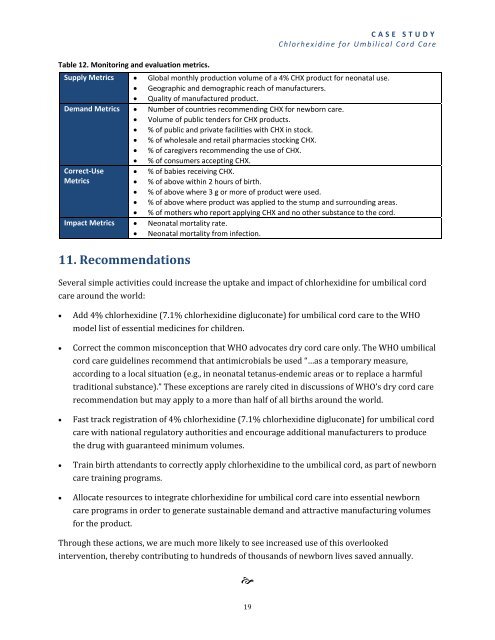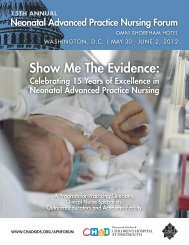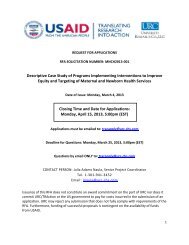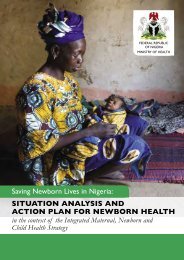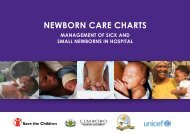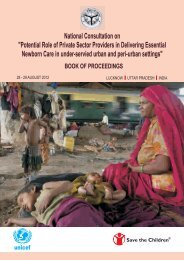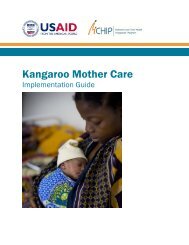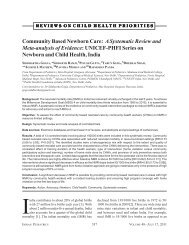Chlorhexidine for Umbilical Cord Care - Healthy Newborn Network
Chlorhexidine for Umbilical Cord Care - Healthy Newborn Network
Chlorhexidine for Umbilical Cord Care - Healthy Newborn Network
- No tags were found...
Create successful ePaper yourself
Turn your PDF publications into a flip-book with our unique Google optimized e-Paper software.
Table 12. Monitoring and evaluation metrics.CASE STUDY<strong>Chlorhexidine</strong> <strong>for</strong> <strong>Umbilical</strong> <strong>Cord</strong> <strong>Care</strong>Supply Metrics Global monthly production volume of a 4% CHX product <strong>for</strong> neonatal use. Geographic and demographic reach of manufacturers. Quality of manufactured product.Demand Metrics Number of countries recommending CHX <strong>for</strong> newborn care. Volume of public tenders <strong>for</strong> CHX products. % of public and private facilities with CHX in stock. % of wholesale and retail pharmacies stocking CHX. % of caregivers recommending the use of CHX. % of consumers accepting CHX.Correct‐Use % of babies receiving CHX.Metrics % of above within 2 hours of birth. % of above where 3 g or more of product were used. % of above where product was applied to the stump and surrounding areas. % of mothers who report applying CHX and no other substance to the cord.Impact Metrics Neonatal mortality rate. Neonatal mortality from infection.11. RecommendationsSeveral simple activities could increase the uptake and impact of chlorhexidine <strong>for</strong> umbilical cordcare around the world:Add 4% chlorhexidine (7.1% chlorhexidine digluconate) <strong>for</strong> umbilical cord care to the WHOmodel list of essential medicines <strong>for</strong> children.Correct the common misconception that WHO advocates dry cord care only. The WHO umbilicalcord care guidelines recommend that antimicrobials be used “…as a temporary measure,according to a local situation (e.g., in neonatal tetanus‐endemic areas or to replace a harmfultraditional substance).” These exceptions are rarely cited in discussions of WHO’s dry cord carerecommendation but may apply to a more than half of all births around the world.Fast track registration of 4% chlorhexidine (7.1% chlorhexidine digluconate) <strong>for</strong> umbilical cordcare with national regulatory authorities and encourage additional manufacturers to producethe drug with guaranteed minimum volumes.Train birth attendants to correctly apply chlorhexidine to the umbilical cord, as part of newborncare training programs.Allocate resources to integrate chlorhexidine <strong>for</strong> umbilical cord care into essential newborncare programs in order to generate sustainable demand and attractive manufacturing volumes<strong>for</strong> the product.Through these actions, we are much more likely to see increased use of this overlookedintervention, thereby contributing to hundreds of thousands of newborn lives saved annually.19


